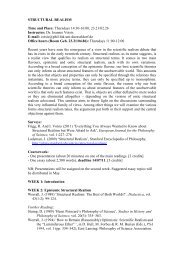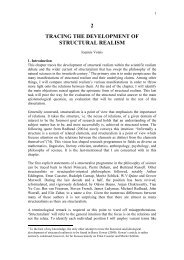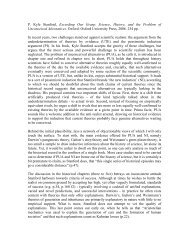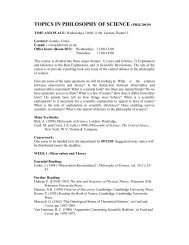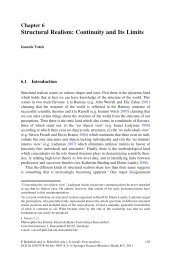Review of Anjan Chakravartty's A Metaphysics for ... - Ioannis Votsis
Review of Anjan Chakravartty's A Metaphysics for ... - Ioannis Votsis
Review of Anjan Chakravartty's A Metaphysics for ... - Ioannis Votsis
Create successful ePaper yourself
Turn your PDF publications into a flip-book with our unique Google optimized e-Paper software.
A <strong>Metaphysics</strong> <strong>for</strong> Scientific Realism<br />
By A. CHAKRAVARTTY<br />
Cambridge University Press, 2007, xvi + 251 pp.<br />
Conducted almost exclusively at the epistemological level the scientific realism<br />
debate <strong>of</strong>ten ignores metaphysical niceties. In the face <strong>of</strong> the scientific realist’s<br />
systematic appeal to metaphysical notions like causation and natural kinds the neglect<br />
seems dissonant. Chakravartty aspires to overturn it with a bespoke metaphysics <strong>for</strong><br />
scientific realism. In pursuing this aim, he undrapes a more comprehensive vision <strong>of</strong><br />
the scientific realist viewpoint, including a distinctive epistemology.<br />
I will focus my critical remarks on three families <strong>of</strong> issues. The first concerns semirealism,<br />
the author’s own brand <strong>of</strong> epistemological realism that he develops over the<br />
first three chapters and incorporates lessons from two heavyweights in the debate.<br />
Semi-realism, roughly speaking, is the view that entities can be known via their<br />
properties’ causal interactions with detectors – following entity realism (ER) – and<br />
this knowledge primarily concerns the relations these properties stand in – following<br />
epistemic structural realism (SR). Chakravartty’s hybrid view deserves more attention<br />
than it has heret<strong>of</strong>ore received. To present it in the most attractive light, however, he<br />
regrettably caricatures certain aspects <strong>of</strong> ER and <strong>of</strong> SR. Take ER. Despite their<br />
general aversion towards theory, ER supporters sanction some low-level theoretical<br />
claims that feature in localised causal interactions. Chakravartty downplays such<br />
qualifications to amplify the dissimilarities between ER and SR and to thereby place<br />
semi-realism as the auspicious redeemer.<br />
The reader also gets a less than subtle portrayal <strong>of</strong> SR. The author incorrectly<br />
attributes the view that SR restricts knowledge to second or higher-order properties to<br />
Bertrand Russell (59). Only Grover Maxwell cast SR in those terms. Since by all<br />
accounts SR limits scientific knowledge to isomorphic specification, it follows, contra<br />
Maxwell, that even entities and their first-order properties can be known up to<br />
isomorphism. Or consider the Ramsey sentence approach that some SR supporters,<br />
including Maxwell, favour. The process <strong>of</strong> Ramsification existentially quantifies over<br />
all theoretical predicates and turns them into variables regardless <strong>of</strong> whether they<br />
represent first or higher-order properties. Of course <strong>for</strong> Chakravartty this is a moot<br />
point since in his eyes no less than the complete identification <strong>of</strong> the entities, their<br />
first-order properties and their relations will suffice <strong>for</strong> realist purposes. How is this<br />
complete identification to be achieved? The author gestures in various directions but<br />
falls short <strong>of</strong> supplying an unequivocal example <strong>of</strong> such knowledge or at least a<br />
positive argument <strong>for</strong> its attainability.<br />
The second family <strong>of</strong> issues concerns the author’s metaphysical vision. To motivate<br />
the legitimacy <strong>of</strong> metaphysical inquiry, Chakravartty draws an analogy between<br />
speculation about unobservables in science and speculation about metaphysics in<br />
philosophy. Although the <strong>for</strong>mer runs a greater risk <strong>of</strong> failure since scientific theories<br />
are expected to generate novel predictions, he stresses that this difference is a matter<br />
<strong>of</strong> degree since not all sciences generate such predictions. More crucially, in the<br />
author’s view the legitimacy <strong>of</strong> a <strong>for</strong>m <strong>of</strong> inquiry cannot be settled on rational grounds<br />
but depends on the values one endorses (25). The first part <strong>of</strong> Chakravartty’s<br />
reasoning is erroneous. Many realists, purge sciences or theories as immature and<br />
epistemically unworthy when they are incapable <strong>of</strong> generating novel predictions, i.e.
when they merely accommodate the data. To thus suggest that the existence <strong>of</strong><br />
immature sciences somehow lends credence to metaphysical speculation is selfdefeating.<br />
Indeed even the author’s conviction that metaphysical beliefs are fallible<br />
since they ‘can lose out’ (23) is tricky to maintain in the absence <strong>of</strong> an argument that<br />
real progress can be made in metaphysics - essentialism and nominalism are just two<br />
<strong>of</strong> many metaphysical theories that keep getting disinterred.<br />
What about the author’s specific metaphysical proposals, developed chiefly over<br />
chapters four to six? Chakravartty’s self-pr<strong>of</strong>essed ‘relatively modest’ and nonexclusive<br />
approach to metaphysics ring sensible at first. However, the generally<br />
unrevealing attitude towards the appropriate level <strong>of</strong> metaphysical engagement is<br />
ultimately precarious as the reader naturally wonders whether many <strong>of</strong> the details <strong>of</strong><br />
the author’s own proposals pass muster. These misgivings are not helped by the fact<br />
that some <strong>of</strong> Chakravartty’s objections have a boomerang quality. Take, <strong>for</strong> example,<br />
his dismissal <strong>of</strong> certain types <strong>of</strong> explanations about the mechanism <strong>of</strong> causation.<br />
Chakravartty carps, ‘[m]etaphors abound: links; chains; ties; glue; cement; bringing<br />
things about; and perhaps most highly scorned <strong>of</strong> all, the “powers” <strong>of</strong> ancient<br />
metaphysics’ (101). In their stead, he puts <strong>for</strong>th the view that ‘[c]ausal phenomena are<br />
produced by the ways in which property-conferred dispositions are linked to one<br />
another’ (112). How is the author’s explanation more edifying than the one citing<br />
chains, glue or cement? In what way have dispositions superceded ‘the powers <strong>of</strong><br />
ancient metaphysics’, if, by the author’s own admission (113), the explanatory benefit<br />
<strong>of</strong> dispositions can only be gleaned metaphorically?<br />
The third family <strong>of</strong> issues concerns Chakravartty’s analysis <strong>of</strong> the notion <strong>of</strong><br />
approximate truth, sketched over chapters seven and eight. The analysis is prompted<br />
by the apparent inadequacy <strong>of</strong> the existing literature to explore in-depth the notion’s<br />
qualitative, as opposed to quantitative, details. From the author’s standpoint theories<br />
deviate from the truth either by idealisation – when the postulated relations between<br />
causal properties ‘do not exist as described’ – or by abstraction – when the<br />
descriptions <strong>of</strong> postulated relations are correct but ‘applied to different circumstances’<br />
– indeed most <strong>of</strong>ten by both (147-148). Chakravartty’s call <strong>for</strong> a qualitative analysis<br />
<strong>of</strong> the notion <strong>of</strong> approximate truth would benefit from a firmer footing. At least some<br />
<strong>of</strong> his account’s presumably unique features, e.g. that more abstract theories are less<br />
approximately true than less abstract ones, drop out <strong>of</strong> the very quantitative treatments<br />
he criticises (222-223). What is more, the distinction between abstraction and<br />
idealisation cannot easily be upheld. Abstracting parameters and idealising them seem<br />
inseparable. Take the pendulum example. Removing ‘air-resistance’ is considered by<br />
Chakravartty to be an abstraction but it is also an idealisation since by abstracting we<br />
simplify the nature <strong>of</strong> the pendulum’s interactions with its surroundings. Similarly,<br />
representing the bob as a point mass is taken by the author to be an idealisation <strong>of</strong> its<br />
nature yet it is also an abstraction <strong>of</strong> a number <strong>of</strong> its features, e.g. that it has an<br />
extension, that its mass is not uni<strong>for</strong>mly distributed, etc.<br />
It is, <strong>of</strong> course, all too easy to find flaws in a book. I will there<strong>for</strong>e end this review<br />
with some notes <strong>of</strong> praise, occasions <strong>of</strong> which there are plenty. First, a testament to a<br />
selection <strong>of</strong> thoughts I found rousing. One thought, <strong>of</strong> which we admittedly get only a<br />
glimpse, fashions causation as the continuous alteration <strong>of</strong> interacting properties (§<br />
4.4). A potential upshot <strong>of</strong> this idea is a more faithful way to model dynamical<br />
systems in nature. Perhaps a more enticing thought concerns the author’s articulation
<strong>of</strong> a weak notion <strong>of</strong> necessity, according to which things are compelled in the actual<br />
world without implication <strong>for</strong> other possible worlds (§ 5.2). This construal <strong>of</strong><br />
necessity unshackles the realists from excessive metaphysics while still permitting<br />
them to maintain a discrepancy between laws <strong>of</strong> nature and accidental regularities. A<br />
final thought worth bringing up concerns the author’s view that natural kinds should<br />
not be tied only to essence kinds. Since the most desirable characteristic <strong>of</strong> natural<br />
kinds is their ability to support successful inductive practices, it is reasonable to<br />
suppose that kinds possessing this characteristic but whose members do not share<br />
essences should also be admitted into the natural kind club (§ 6.2). Over and above<br />
these ideas, Chakravartty deserves credit <strong>for</strong> his perceptiveness in pre-empting a great<br />
many potential objections. I recommend this book, particularly, but not only, to those<br />
who want to study in earnest the interface between the metaphysics and the<br />
epistemology <strong>of</strong> scientific realism.<br />
IOANNIS VOTSIS<br />
Philosophisches Institut<br />
Heinrich Heine Universität Düsseldorf<br />
Universitätsstraße 1<br />
Gebäude 23.21/04.86<br />
D-40225 Düsseldorf<br />
Germany<br />
votsis@phil-fak.uni-duesseldorf.de



